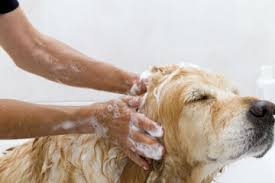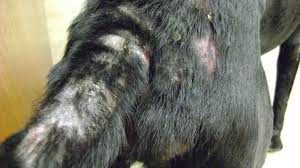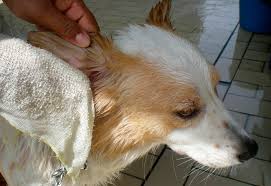 Keeping your dog clean helps keep him healthy. Here’s how to win his willing participation in the job.
Keeping your dog clean helps keep him healthy. Here’s how to win his willing participation in the job.
From toenails to teeth to tail, grooming is an intimate, personal issue. We groom our dogs for their health and cleanliness and satisfaction of seeing them look their best. But the process can invoke physical pain (an aching back, for instance!) as well as feelings of impatience and frustration in both groomer and groomee.
Grooming your dog when your disgruntled, or procrastinating and avoiding the issue, are both like abusing credit cards: you may get what you want now, but you can’t avoid having to pay the bill-with interest-later. Your dog pays with a reduction in her health and an increase in her stress and discomfort. You pay with time and money spent at the groomer or veterinarians office. Your relationship with your dog also suffers from a breach of trust.
Your dog also has her own perceptions and feelings about being groomed. One dog may balk and back away from the bathroom door. Another may gouge the floor during her great escape from a nail trim. A third may tremble at the sight of a flea comb. A fourth may stand still avoiding going through the door of the grooming salon.
Attempts to groom under these circumstances can not only exacerbate a problem, but set up a mutually damaging cycle: the more she resists, the more you”ll dislike grooming her. The more you shirk this duty, the more likely she’ll develop some of the very conditions grooming helps to prevent.
 Procrastinating or neglecting to groom your dog can cause skin problems and pain from dirty, matted fur, gait problems and joint stress from overly long toenails, hearing loss from clogged or damaged ears, local and systemic infections from gingivitis, and any number of health problems from undetected and untreated flea and tick infestations.
Procrastinating or neglecting to groom your dog can cause skin problems and pain from dirty, matted fur, gait problems and joint stress from overly long toenails, hearing loss from clogged or damaged ears, local and systemic infections from gingivitis, and any number of health problems from undetected and untreated flea and tick infestations.
Positively Clean
Take your time and make every grooming session enjoyable for your dog. Keep in mind that you won’t be doing him any favors if you yell at him or forcibly restrain him, this will only make future sessions more difficult for you, your veterinarian and groomer.
Conduct grooming sessions when your dog is very relaxed and unlikely to be bothered with the procedure. A perfect time is in the evening, after your dog has enjoyed a tiring run or play session and a delicious dinner, and all he wants to do is lie sleepily on the carpet. Keep a supply of small, but tasty treats on hand, so you can occasionally dole them out in appreciation of his cooperation.
If your dog doesn’t like having some part of his anatomy touched or probed, start by rewarding him with a treat for each momentary touch in the contested territory. If he won’t sit still for you to look into ears, for example, spend a minute every day training him to tolerate -and even look forward to-having his ears examined or cleaned. Place one hand on your dog’s ear, just for a second, and then give him a treat with your other hand. Repeat this a dozen or so times, not paying attention to his wriggly away or trying to make him sit still.
 It won’t take him long to understand that your touch on his ear predicts a treat, and when he gets this, you”ll find that you can touch his ear for several seconds longer each time. Vary your ministrations, mixing up the type and duration of your touch, all the while offering treats and encouragement. If he wiggles or pulls away from you, just say brightly, “Oh, too bad!” and remove your attention and treats.
It won’t take him long to understand that your touch on his ear predicts a treat, and when he gets this, you”ll find that you can touch his ear for several seconds longer each time. Vary your ministrations, mixing up the type and duration of your touch, all the while offering treats and encouragement. If he wiggles or pulls away from you, just say brightly, “Oh, too bad!” and remove your attention and treats.
If you undertake a one minute session (or a few) like this every day, within a couple of weeks, you should be able to lift and hold his ear flap while getting a good look inside.
The same process works for haircuts or nail trimming. The key is to do a tiny bit at a time, never pushing to the point that the dog struggles, or panics or fights you. As the supposedly more intelligent species, and as positive owners, it is our job to get our dogs to voluntarily give us the behaviors we want without having to use force. Stop and ask yourself, “What’s the rush? Why do I have to do all this in one sitting? And anytime you wield scissors or clippers, err way overboard on the side of caution. There is nothing like quicking a nail, pinching skin or pulling matted hair to convince your dog that he is justified in resisting your attentions.
Sure you can overpower some dogs and win the grooming battle. Some will even submit and learn to accept being groomed by force. But some won’t. You can get bitten in the process, make your dog hate grooming even more, or create a dog who will not tolerate having his feet handled as an example. Worst of all, in the long run, you can do permanent and serious damage to your relationship with your dog. Never force your dog’s compliance with physical strength or intimidation. Take your time and use positive methods to gain his trust and comfort. You won’t want your groomer having to muzzle and restrain him forcibly to groom him. This causes stress and anxiety and a dislike for the grooming process.
These practices should be started at 8 weeks old, as soon as you bring your puppy home. Your groomer will thank you!
Sabra Learned & Pat Miller





